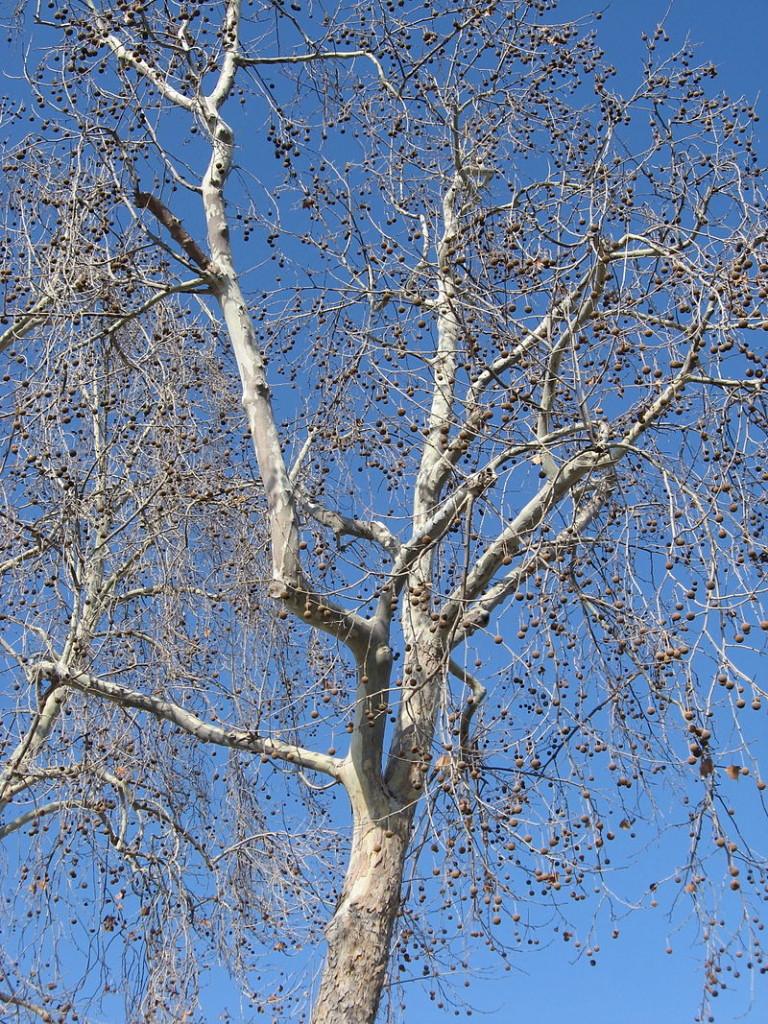Platanus racemosa or California Sycamore is our pick for California Heritage Plant for June 2017
This Sycamore is a common sight along city streets where it offers large shade canopies, requires little water to establish and no irrigation upon maturity, doesn’t disturb sidewalks much and has few pest and disease problems worth mentioning. A mature specimen can reach 100ft! But most large trees we see have made it to 50ft. growth and have begun to transition to a much slower metabolism and growth rate. Leaves turn lovely shades of brown and red before falling and female flowers drop numerous seed bearing achenes. Birds enjoy the tiny fruit and several birds prefer to nest in its high branches. Wood from the California Sycamore is difficult to work but makes excellent food cutting boards.
The native people of California had a very different relationship with this tree, where Sycamore stands grew naturally they were maintained, expanded and replanted over generations by native tribal groups, an activity which they engaged and planned out over many thousands of years. One can imagine when considering the range of this tree and the incredible language diversity of California Natives (second only to New Guinea) there was probably some delicate and ingenious negotiation to accomplish this task. This forestry activity using and managing California Sycamores provided erosion control, enhanced and created bird habitat (making it easy to hunt birds, collect feathers and gather eggs) and managed and maintained a source of wood for fuel and roofing. Probably the shade canopies created part sun planting areas where valuable berry producing shrubs could flourish.
How do we know these people did these things?
Distribution of these Sycamore trees observed in undisturbed parts of California reveal a pattern of growth which cannot be accounted for by the biological means by which this tree spreads naturally. Oral histories of native people which survive in the work of ethnographers from the early 19th century tell of a forestry management system for other similar trees and useful perennial plants; this was common practice by people who maintained a sustainable food system for over 15000 years. That’s pretty impressive when you consider that our system of agriculture will fail in this state in fifty or so years if not altered radically.
We can thank NASA and the technology of satellite image systems for providing us with this glimpse into the forestry management system of a lost civilization. Satellite images and data produced from orbital cameras reveal in detail how different species are distributed over large regions so accurately and efficiently, the slow and imperfect surveys of botanists of days past pales in comparison. If you find this exciting, you might look up how this same technology is revealing similar and even more intensive natural resource management across the entire ‘wild’ Amazon rain forest basin of South America. The implications are that at one time or the other the entire extant of wild rain forest had been controlled and maintained for food production to the benefit of people living there. There is no ‘natural rain-forest’ , every grouping of plant species we see today are not as nature would have it if species had spread uninterrupted and ignored by humans, but rather we are seeing a vast garden, a system of agriculture run wild when the civilizations which created them disappeared.
15gallon Platanus racemosa ‘California Sycamore’ $129.00 at Ploughshares Nursery
